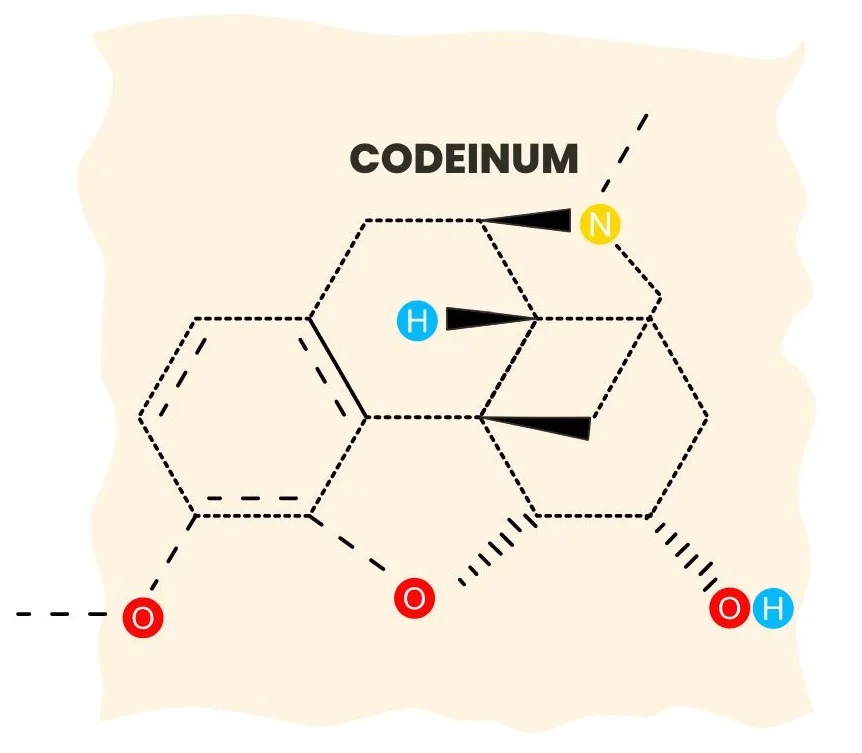Codeinum, commonly known as Codeine, is an alkaloid derived from opium.
It is widely used in homeopathy and conventional medicine for its analgesic (pain-relieving) and antitussive (cough-suppressing) properties.
This remedy is particularly effective for treating conditions involving pain, respiratory issues, and neurological disturbances.
Understanding its classification, origin, historical significance, and clinical applications can provide insights into its effective use in homeopathic practice.

SOURCE INFORMATION
Scientific Classification
- Kingdom: Plantae
- Clade: Angiosperms
- Clade: Eudicots
- Order: Ranunculales
- Family: Papaveraceae
- Genus: Papaver
- Species: Papaver somniferum
Origin
- Codeine is derived from the opium poppy (Papaver somniferum), which is native to the Mediterranean region and parts of Asia.
- The poppy has been cultivated for thousands of years for its medicinal properties.
- The opium poppy is harvested for its latex, which contains a variety of alkaloids, including morphine and codeine.
Historical Facts
- Ancient Use: The use of opium dates back to ancient Mesopotamia, around 3400 BCE, where it was referred to as the “joy plant” due to its euphoric effects.
- Discovery of Codeine: Codeine was first isolated in 1832 by French chemist Pierre Robiquet.
- It was later introduced into medicine in the mid-19th century as a less potent alternative to morphine.
- Modern Use: Today, Codeine is used in various formulations, including tablets, syrups, and cough suppressants, and is a key ingredient in many prescription medications.
DRUG PATHOGENESIS
Codeinum acts primarily on the central nervous system, where it binds to opioid receptors to modulate pain perception and suppress the cough reflex. Its pathogenesis can be characterized by several key symptoms:
- Neurological Effects: Codeine may cause trembling and involuntary muscle twitching, indicating its influence on motor control.
- Respiratory Effects: It is particularly effective in treating dry and irritating coughs, especially those that worsen at night.
- Gastrointestinal Effects: It can lead to spasmodic pain in the stomach and increased thirst, often for bitter substances.
DIATHESIS
- Codeinum is generally suited for individuals with a neurasthenic constitution, characterized by fatigue, sensitivity to stimuli, and a tendency towards neuroses.
TEMPERAMENTS
- It is most effective for patients with a melancholic temperament who may exhibit signs of anxiety and nervousness.
KEY CHARACTERISTICS
- Trembling and Twitching: Patients often experience general trembling of the body and involuntary muscle twitching, particularly in the arms and lower limbs.
- Sore Skin: The skin, especially on the face and scalp, may feel sore or sensitive following episodes of neuralgia.
- Respiratory Symptoms: A dry cough that becomes more pronounced at night, often accompanied by thick, purulent expectoration.
DETAILED ORGAN SYMPTOMS
HEAD
- Pain: Patients report pain that starts from the occiput (the back of the head) and extends to the neck.
- This pain can feel intense and debilitating, often exacerbated by movement.
- Soreness: The skin on the face and scalp may become tender, particularly after episodes of neuralgia, indicating nerve irritation.
EYES
- Twitching: Involuntary twitching of the eyelids, similar to the effects seen with Agaricus, indicating potential neurological disturbances.
STOMACH
- Spasmodic Pain: Patients may experience sharp, cramping pains in the pit of the stomach, often accompanied by belching (eructations) and a strong thirst for bitter substances.
RESPIRATORY SYSTEM
- Cough: Characterized as short and irritating, this cough is worse at night and may be accompanied by purulent (pus-like) expectoration, indicative of underlying infection or inflammation.
MODALITIES
- Worse: Symptoms tend to worsen at night and can be aggravated by movement or bright lights.
- Better: Patients may find relief from symptoms through rest and sleeping, which helps to reduce sensitivity and irritability.
RELATIONSHIP WITH OTHER DRUGS
Compare
- Opium: For its potent analgesic properties and effects on pain relief.
- Agaricus: For neurological symptoms, particularly twitching.
- Hyoscyamus: For its effects on restlessness and spasmodic actions.
- Ammonium Bromatum: For respiratory issues and cough suppression.
DOSE
- Potency: The typical dose of Codeinum ranges from one-quarter grain (approximately 16.2 mg) to the third trituration, depending on the severity of symptoms and practitioner discretion.
Frequently Asked Questions
What conditions can Codeinum help with?
- Codeinum is effective for managing pain, treating dry coughs, and alleviating symptoms of respiratory infections.
How does Codeinum work?
- It interacts with opioid receptors in the brain to reduce pain perception and suppress the cough reflex.
Is it safe to use Codeinum?
- Yes, when used as directed in homeopathy. It is essential to consult with a homeopathic practitioner for appropriate usage.
How should Codeinum be taken?
- It is typically administered in one-quarter grain doses or as recommended by a homeopathic professional.
Can Codeinum be used in children?
- Yes, but dosages should be adjusted based on age and specific health conditions, under the supervision of a healthcare provider.
Glossary of Difficult Words
- Alkaloid: A naturally occurring compound that often has pharmacological effects.
- Eructation: The act of expelling gas from the stomach through the mouth (belching).
- Expectoration: The process of coughing up and spitting out mucus or phlegm from the respiratory tract.
- Neurasthenic: Relating to a condition characterized by fatigue, anxiety, and other psychological symptoms.
- Purulent: Containing pus, indicating infection or inflammation.
- Spasmodic: Relating to involuntary muscle contractions or spasms.
- Trituration: The process of diluting and succussing a substance to prepare homeopathic remedies.
This comprehensive overview of Codeinum provides insights into its scientific classification, pathogenesis, clinical applications, and relationship with other homeopathic remedies, serving as a valuable resource for practitioners and patients alike.
